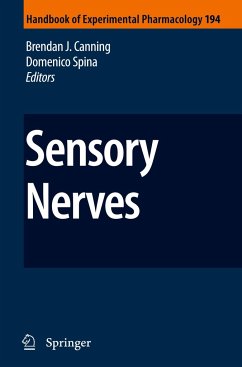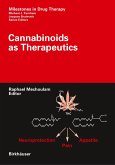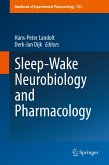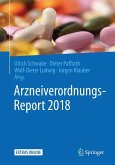The intention of this book is to provide a comprehensive and contemporary review of the biology of sensory nerves. In keeping with the theme of the Handbook series, an emphasis will be placed on the actions of drugs, transmitters and autacoids that initiate or inhibit sensory nerve activation (through actions on ion channels and receptors at their peripheral terminals) or modulate the release or actions of the transmitters released from the central terminals of sensory nerves. Based on extensive supportive evidence in the literature, it is our view that many diseases are characterised by alterations in sensory nerve function (eg pain, cardiovascular disease, and migraine). It is our belief that this book will be unique, as it will comprehensively cover the role of sensory nerves across many therapeutic areas.
Theintentionofthisbookistoprovideacomprehensiveandcontemporaryreview ofthebiologyofsensorynerves. InkeepingwiththethemeoftheHandbookof Experimental Pharmacology series, emphasis will be placed on the actions of drugs,transmittersandautacoidsthatinitiateorinhibitsensorynerveactivation (through actionsonionchannelsandreceptorsattheirperipheralterminals)or modulate the release or actions of the transmitters released from the central terminalsofsensorynerves. Onthebasisofextensivesupportiveevidenceinthe literature, it is our view that many diseases are characterized by alterations in sensorynervefunction(e. g. pain,cardiovasculardiseaseandmigraine). Itisour beliefthatthisbookwillbeunique,asitwillcomprehensivelycovertheroleof sensory nerves across many therapeutic areas. To address directly one of the editorialboardqueries,thisisnotintendedtobeabookaboutthepharmacology ofpain. Thatsaid,tomostpharmacologists,painisthemostobviousindicationfor aroleorsensorynervesindisease. Webelievethatthelessonslearntfromthestudy ofneuropathicpainwillbeinvaluableforresearchersintheothertherapeuticareas covered inthisvolume. Sincemostinterest hasfocusedontheroleofsensory nervesinneuropathicpain,wehaveaddedanumberofchaptersdevotedtothis subject. Thebookisorganizedinthreeparts,coveringthetypesandrolesofsensory nervesinsomaticandvisceraldisorders(PartI),speci?ctargetsonsensorynerves relevanttopainandvisceraldisorders(PartII)andadescriptionofcurrentand futuretherapeuticstrategiesfortargetingsensorynerves(PartIII). The?rsttwochaptersinPartIaredevotedtodescribingtheclinicalfeaturesof neuropathicpainandvisceralpain. Ourintentionisfortheauthorstoprovidea clinicalviewpointonthefeaturesoftheseconditionsandtheadvantages/disadv- tagesofcurrenttreatmentmodalities. Thenext?vechaptersinPartIfocusonthe roleofsensorynervesinotherpathologicalconditions. Severalcommonthemes willemergeinthispart,includingthemodeofsensorynerveactivationinvarious tissues and organs, the alterations in sensory nerve excitability associated with disease,andtheimportanceofin?ammationandin?ammatorymediatorsininiti- ingalteredsensorynervefunctionindisease. v vi Preface Whilstthe?rstpartfocusesontheclinicaland/orsystemsphysiology,PartIIhas itsfocusatthecellandmolecularlevel. Thisparthighlightsthecurrentundersta- ingofproteins/ionchannels/mediatorsthathavecreatedthemostintenserecent interestintheareaofsensorynervebiology. Together,thesechapterswillgivethe reader important knowledge about how sensory nerve function can be altered pharmacologically. Thelastchapterinthispartdescribestheprocessesthatgive risetoalteredneuralre?exesatthecentrallevel. Themechanismsdescribedin thesechaptersreinforcetheroleofproteins/mediatorshighlightedinthepreceding chapters. Theroleofthesecellular,molecularandphysiologicalprocessesinthe diseasesdiscussedinPart1areemphasized. TheaimofPartIIIistohighlightpotentialdrugtargetsthatmightaltersensory nervefunction. Mostoftheworkhasbeendevotedtothetreatmentofneuropathic painandsothispartheavilyemphasizesthissubject. However,aswillbeapparent fromPartI,manyofthesetargetscouldbeutilizedinothertherapeuticareasthat implicatesensorynervesintheirpathophysiologicalprocesses. Thefocusofthe chaptersisonopioidsandmodulatorsofionchannelsandthenthe?nalchapteris devotedtofuturetreatmentstrategiesforneuropathicpain. Finally,wewouldliketothankallthecontributors,includingco-authors,who agreedtowritechaptersforthisbookandthepublishers,especiallySusanneDathe, fortheirpatienceandassistance. Baltimore B. J. Canning London D. Spina Contents PartI RoleofSensoryNervesinDisease NeuropathicPain:AClinicalPerspective . . . . . . . . . . . . . . . . . . . . . . . . . . . . . . . . . . . . . 3 RalfBaron VisceralPain:TheNeurophysiologicalMechanism. . . . . . . . . . . . . . . . . . . . . . . . . . 31 JyotiN. Sengupta Migraine . . . . . . . . . . . . . . . . . . . . . . . . . . . . . . . . . . . . . . . . . . . . . . . . . . . . . . . . . . . . . . . . . . . . . . . . . 75 SilviaBenemei,PaolaNicoletti,J
Theintentionofthisbookistoprovideacomprehensiveandcontemporaryreview ofthebiologyofsensorynerves. InkeepingwiththethemeoftheHandbookof Experimental Pharmacology series, emphasis will be placed on the actions of drugs,transmittersandautacoidsthatinitiateorinhibitsensorynerveactivation (through actionsonionchannelsandreceptorsattheirperipheralterminals)or modulate the release or actions of the transmitters released from the central terminalsofsensorynerves. Onthebasisofextensivesupportiveevidenceinthe literature, it is our view that many diseases are characterized by alterations in sensorynervefunction(e. g. pain,cardiovasculardiseaseandmigraine). Itisour beliefthatthisbookwillbeunique,asitwillcomprehensivelycovertheroleof sensory nerves across many therapeutic areas. To address directly one of the editorialboardqueries,thisisnotintendedtobeabookaboutthepharmacology ofpain. Thatsaid,tomostpharmacologists,painisthemostobviousindicationfor aroleorsensorynervesindisease. Webelievethatthelessonslearntfromthestudy ofneuropathicpainwillbeinvaluableforresearchersintheothertherapeuticareas covered inthisvolume. Sincemostinterest hasfocusedontheroleofsensory nervesinneuropathicpain,wehaveaddedanumberofchaptersdevotedtothis subject. Thebookisorganizedinthreeparts,coveringthetypesandrolesofsensory nervesinsomaticandvisceraldisorders(PartI),speci?ctargetsonsensorynerves relevanttopainandvisceraldisorders(PartII)andadescriptionofcurrentand futuretherapeuticstrategiesfortargetingsensorynerves(PartIII). The?rsttwochaptersinPartIaredevotedtodescribingtheclinicalfeaturesof neuropathicpainandvisceralpain. Ourintentionisfortheauthorstoprovidea clinicalviewpointonthefeaturesoftheseconditionsandtheadvantages/disadv- tagesofcurrenttreatmentmodalities. Thenext?vechaptersinPartIfocusonthe roleofsensorynervesinotherpathologicalconditions. Severalcommonthemes willemergeinthispart,includingthemodeofsensorynerveactivationinvarious tissues and organs, the alterations in sensory nerve excitability associated with disease,andtheimportanceofin?ammationandin?ammatorymediatorsininiti- ingalteredsensorynervefunctionindisease. v vi Preface Whilstthe?rstpartfocusesontheclinicaland/orsystemsphysiology,PartIIhas itsfocusatthecellandmolecularlevel. Thisparthighlightsthecurrentundersta- ingofproteins/ionchannels/mediatorsthathavecreatedthemostintenserecent interestintheareaofsensorynervebiology. Together,thesechapterswillgivethe reader important knowledge about how sensory nerve function can be altered pharmacologically. Thelastchapterinthispartdescribestheprocessesthatgive risetoalteredneuralre?exesatthecentrallevel. Themechanismsdescribedin thesechaptersreinforcetheroleofproteins/mediatorshighlightedinthepreceding chapters. Theroleofthesecellular,molecularandphysiologicalprocessesinthe diseasesdiscussedinPart1areemphasized. TheaimofPartIIIistohighlightpotentialdrugtargetsthatmightaltersensory nervefunction. Mostoftheworkhasbeendevotedtothetreatmentofneuropathic painandsothispartheavilyemphasizesthissubject. However,aswillbeapparent fromPartI,manyofthesetargetscouldbeutilizedinothertherapeuticareasthat implicatesensorynervesintheirpathophysiologicalprocesses. Thefocusofthe chaptersisonopioidsandmodulatorsofionchannelsandthenthe?nalchapteris devotedtofuturetreatmentstrategiesforneuropathicpain. Finally,wewouldliketothankallthecontributors,includingco-authors,who agreedtowritechaptersforthisbookandthepublishers,especiallySusanneDathe, fortheirpatienceandassistance. Baltimore B. J. Canning London D. Spina Contents PartI RoleofSensoryNervesinDisease NeuropathicPain:AClinicalPerspective . . . . . . . . . . . . . . . . . . . . . . . . . . . . . . . . . . . . . 3 RalfBaron VisceralPain:TheNeurophysiologicalMechanism. . . . . . . . . . . . . . . . . . . . . . . . . . 31 JyotiN. Sengupta Migraine . . . . . . . . . . . . . . . . . . . . . . . . . . . . . . . . . . . . . . . . . . . . . . . . . . . . . . . . . . . . . . . . . . . . . . . . . 75 SilviaBenemei,PaolaNicoletti,J
From the reviews:
"This is a very detailed and comprehensive textbook concerning the energetics, biochemistry, physiology, and neurological implications of sensory nerves. ... this monograph is a welcome addition and primer for medical students, graduate fellows, professors, and physiology research personnel working with human and animal preparations." (Joseph J. Grenier, Amazon.com, February, 2014)
"This is a very detailed and comprehensive textbook concerning the energetics, biochemistry, physiology, and neurological implications of sensory nerves. ... this monograph is a welcome addition and primer for medical students, graduate fellows, professors, and physiology research personnel working with human and animal preparations." (Joseph J. Grenier, Amazon.com, February, 2014)








